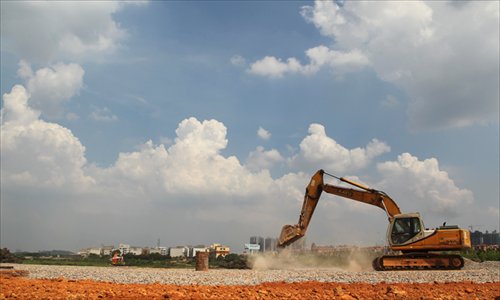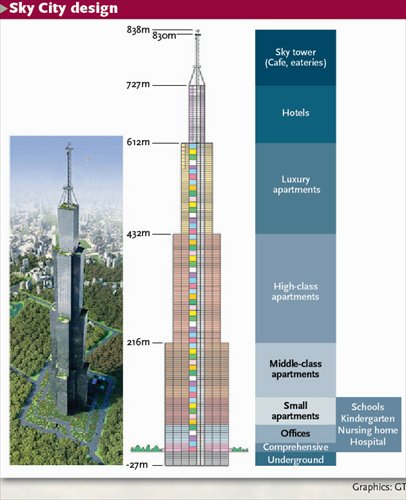Higher and higher vanities

An excavator works on July 19 at the site in Changsha, Hunan Province where an ambitious Sky City, aiming to be the world's tallest tower, is to break ground. Photo: IC

Within just seven months, a new skyscraper named Sky City is aiming to top the 828-meter-high Burj Khalifa in Dubai, currently the world's tallest building, by 10 meters.
But the choice of city may surprise some. While the world's iconic towers usually rise above the skylines of New York, Hong Kong or Shanghai, it is in a suburb of Changsha, the capital of Central China's Hunan Province, that Sky City will be built.
The ground-breaking ceremony was held at the construction site in the village of Huilong in Wangcheng district on July 20. Zhang Yue, CEO of local construction firm Broad Group who landed at the site in a helicopter, announced that the construction of the tower would be finished in April next year and would be ready for use in May or June.
As the project's ad video on the group's website shows, the skyscraper aims to top out at 838 meters. The plan is for Sky City to have 202 floors and a total area of over 1 million square meters, which would allow it to accommodate 30,000 people in residences and offices.
The speed and scale of this project has led to many doubts about the project's feasibility and safety. Broad claims the skyscraper will be safe, capable of resisting earthquakes of up to 9.0 on the Richter scale.
As for the sensational speed of the project, Broad says it can achieve the construction within its allotted time frame by utilizing prefabricated modules to erect the superstructure. Broad has used this technology before, such as when it put up its pavilion at the 2010 Shanghai Expo in a single day. But still, a leap in scale to the magnitude of Sky City would be an enormous coup for the firm if they were to pull it off.
During the project, 20,000 workers will work in factories building the necessary components while 3,000 builders assemble the tower, according to Broad. Its initial stated cost of 9 billion yuan ($1.5 billion) would be similar to the cost of the Burj Khalifa or to both Petronas Towers in Malaysia.
Too many contradictions
However, if the building of Sky City proves to be the same roller-coaster ride as its planning, then all doubts would be well-founded. The sheer number of uncertainties, delays and oddly worded statements surrounding this ambitious project have left the public highly dubious.
One certainty is that Broad Sustainable Building (BSB), a subsidiary of Broad Group, signed an agreement with Wangcheng district government on June 5, 2012. From then, the group said the tower would be finished within seven months, but nothing happened for over a year.
On July 24, four days after the ground-breaking ceremony, local media reported that Sky City was ordered to halt construction by the local government, since it hadn't gone through the right application procedures. This was also verified by the Global Times at the time.
So far, a final conclusion has not yet been reached. The review and evaluation of the tower are still under way and thus building is still delayed.
However, the group's CEO Zhang Yue denied this in an article named "Sky City's positive energy," which the group sent to the Global Times by e-mail on August 1.
"We are utterly devoted to building Sky City, but until now, we have only faced doubts and insults. We were never notified to stop the project, but the whole world is cheering about the fact the project was "halted," the article reads.
Environmental protection organizations have stated that the project would destroy the local ecology, given the amount of water it would take from nearby wetlands, since even work on its foundations would require drawing water from nearby wetlands. But Zhang excoriated his doubters for lacking logic.
"The higher the building is, the less land resources we'll use, and thus more trees and crops can be planted. This contributes to a much better ecology," Zhang wrote.
But Feng Yongfeng, initiator of Nature University, an NGO dedicated to environmental protection, holds different opinions.
Feng wrote on his Weibo that the construction of Sky City would see the filling in of Daze Lake, a very important wetland for the local environment and one of the last wetlands in Changsha which is essential for migratory birds.
Feng's organization has dispatched teams of volunteers in Changsha to document the building site.
However, Zhang has still not addressed the most pressing issue, whether Broad has already obtained the necessary construction permits. The media have interpreted this stance as Zhang seeking to hide the truth.
"Some people say we have started construction without going through the right procedures. Nobody would make such a silly mistake, neither Broad Group nor the local government," he replied.
Media coup?
The architecture community has also been greatly concerned about the quality of Sky City's construction, and whether there is a demand for such an edifice.
One of those concerned is Jiang Huancheng, with Shanghai Xian Dai Architectural Design Group and an academician with the Chinese Academy of Engineering. Jiang famously designed the Oriental Pearl Radio & TV Tower, 468 meters high, in Shanghai.
Jiang says that the move could make sense as skyscrapers are sprouting in many Chinese cities while many local governments or enterprises are competing for the honor of building the highest structure in a certain region.
"It's like an advertisement and this marketing effect is possibly more powerful than the towers themselves," said Jiang.
However, Jiang strongly emphasized that feasibility studies are essential before towers are built, and that local authorities must guide enterprises to do so correctly, no matter the expected benefits to economic development.
Jiang estimated that it usually takes four to five years to build a super-high tower in most countries, with the safest top speed at one story every three days. At this rate, it would take almost two years to finish building Sky City.
The Burj Khalifa was started in September of 2004 and finished only in 2010.
However, Jiang disagrees with experts who said Broad's prefabrication module method could only be used for buildings no taller than 100 meters.
"The technique can be used for higher towers. What technology is being used should not limit the height of the skyscrapers," said Jiang.
Jiang was once invited by Broad Group to visit one of its buildings, the T30 hotel in Xiangyin county of Hunan Province. The 30-floor hotel was finished within 15 days in December 2011. It received a lot of flak online and was deemed an example of "China speed" by foreign media.
Jiang found that the internal layout of T30 left much to be desired. Its corridors and staircases were too narrow while its windows were too few and not well-situated, which could cause problems in emergency situations.
"I wrote about these shortcomings to the group's executives, but got no reply," Jiang recalled. He was not invited to advise the group on Sky City.
Skyscraper boom
Though it sounds fantastical, this kind of ambition is not uncommon in other regions of the country.
Shanghai Tower, to be finished by 2015, will be 632 meters high and will replace the Shanghai World Financial Center, 492 meters, as the highest in the metropolis."Z15" Tower, expected to finish by 2016, will be 528 meters high, becoming Beijing's tallest instead of China World Trade Center Tower 3 at 330 meters.
Sheer one-upmanship has also been responsible. The Wuhan Greenland Center in Hubei Province was originally designed to be 606 meters high, but it was later boosted by 30 meters, simply to surpass the Shanghai Tower.
International standards state that buildings higher than 152 meters count as skyscrapers.
By July of 2012, 470 skyscrapers had been completed in China, 332 were under construction and 516 were being planned, according to statistics from Motian City, a non-governmental think tank.
This compares to the US which has 533 skyscrapers already built, but just 6 under construction and 24 planned by 2022.
It seems nothing can stop the enthusiasm for building skyscrapers while the competition is only becoming fiercer.
"Even knowing clearly there is no way to recoup the massive costs, property developers in some regions are still determined to go higher and higher. This is because they've got a commitment from local governments, selling them land at a much lower price so long as they are willing to make the tallest buildings," Zhai Baohui, researcher with the Policy Research Center under Ministry of Housing and Urban-Rural Development, told the People's Daily.
"These problems are not caused by market factors, but are due to misuse of power. The market doesn't decide, but mayors do and it's their vanity that decides the height of these towers," stated Zhai.
As for Ma Long, a leading architect with the Beijing Institute of Architectural Design, a lack of confidence is to blame.
"We are still in the process of chasing economic or cultural goals since we are not confident in either. As a society, we are too eager to stand out and need constant acknowledgement from others," said Ma.
Building the highest tower is like owning a luxury item, it allows you to show off without being practical, he added.